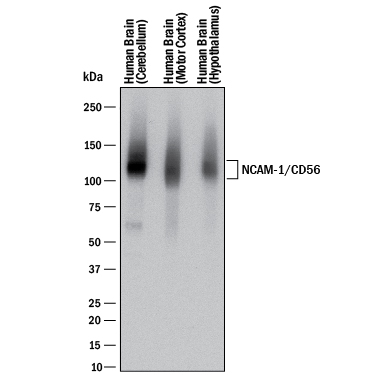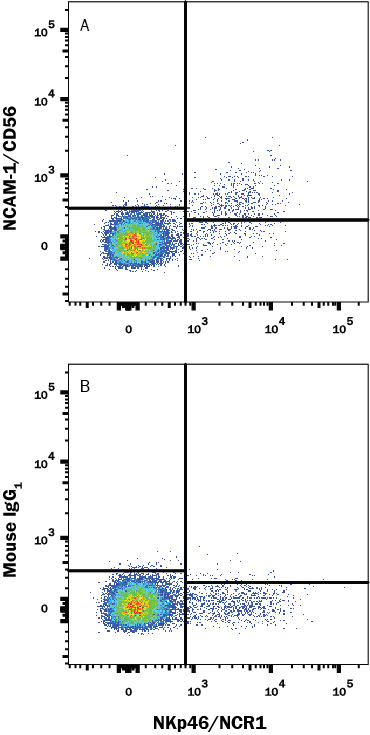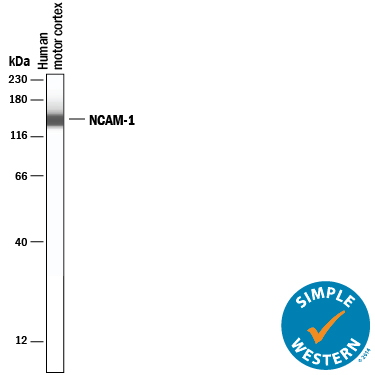Human NCAM-1/CD56 Antibody Summary
Leu20-Pro603 and Glu636-Asn741
Accession # NP_001070150
Applications
Please Note: Optimal dilutions should be determined by each laboratory for each application. General Protocols are available in the Technical Information section on our website.
Scientific Data
 View Larger
View Larger
Detection of Human NCAM‑1/CD56 by Western Blot. Western blot shows lysates of human brain (cerebellum) tissue, human brain (motor cortex) tissue, and human brain (hypothalamus) tissue. PVDF membrane was probed with 0.5 µg/mL of Mouse Anti-Human NCAM-1/CD56 Monoclonal Antibody (Catalog # MAB24084) followed by HRP-conjugated Anti-Mouse IgG Secondary Antibody (Catalog # HAF018). A specific band was detected for NCAM-1/CD56 at approximately 120 kDa (as indicated). This experiment was conducted under reducing conditions and using Immunoblot Buffer Group 1.
 View Larger
View Larger
Detection of NCAM-1/CD56 in Human Peripheral Blood by Flow Cytometry. Human peripheral blood was stained with either (A) Mouse Anti-Human NCAM-1/CD56 Monoclonal Antibody (Catalog # MAB24084) or (B) Mouse IgG1 Isotype Control (Catalog # MAB002) followed by anti-Mouse IgG APC-conjugated secondary antibody (Catalog # F0101B) and Mouse Anti-Human NKp46 PE-conjugated Monoclonal Antibody (Catalog # FAB1850P). View our protocol for Staining Membrane-associated Proteins.
 View Larger
View Larger
Detection of Human NCAM‑1/CD56 by Simple WesternTM. Simple Western lane view shows lysates of human motor cortex tissue, loaded at 0.2 mg/mL. A specific band was detected for NCAM‑1/CD56 at approximately 150 kDa (as indicated) using 20 µg/mL of Mouse Anti-Human NCAM‑1/CD56 Monoclonal Antibody (Catalog # MAB24084). This experiment was conducted under reducing conditions and using the 12-230 kDa separation system.
Reconstitution Calculator
Preparation and Storage
- 12 months from date of receipt, -20 to -70 °C as supplied.
- 1 month, 2 to 8 °C under sterile conditions after reconstitution.
- 6 months, -20 to -70 °C under sterile conditions after reconstitution.
Background: NCAM-1/CD56
Neural cell adhesion molecule 1 (NCAM-1) is a multifunctional member of the Ig superfamily. It belongs to a family of membrane-bound glycoproteins that are involved in Ca++ independent cell matrix and homophilic or heterophilic cell-cell interactions. NCAM-1 specifically binds to heparan sulfate proteoglycans (1), the extracellular matrix protein agrin (2), and several chondroitin sulfate proteoglycans that include neurocan and phosphocan (3). There are three main forms of human NCAM-1 that arise by alternate splicing. These are designated NCAM-120/NCAM-1 (761 amino acids [aa]), NCAM‑140 (848 aa), and NCAM-180 (1120 aa). NCAM-120 is GPI-linked, while NCAM‑140 and NCAM-180 are type I transmembrane glycoproteins (4 - 6). Additional alternate splicing adds considerable diversity to all three forms, and extracellular proteolytic processing is possible for NCAM-180 (7 ‑ 8). NCAM-1 is synthesized as a 761 aa preproprecursor that contains a 19 aa signal sequence, a 722 aa GPI-linked mature region, and a 20 aa C-terminal prosegment (4). The molecule contains five C-2 type Ig-like domains and two fibronectin type-III domains. Human to mouse, NCAM-1 is 93% aa identical. NCAM-1 appears to be highly sialylated. The polysialyation of NCAM-1 reduces its adhesive property and increases its neurite outgrowth promoting features (9). NCAM-1 in the adult brain shows a decline of sialylation relative to earlier developmental periods. In regions that retain a high degree of neuronal plasticity, however, the adult brain continues to express polysialylation-NCAM-1, suggesting sialylation of NCAM-1 is involved in regenerative processes and synaptic plasticity (10 - 13).
- Burg, M.A. et al. (1995) J. Neurosci. Res. 41:49.
- Storms, S.D. and U. Rutishauser (1998) J Biol. Chem. 273:27124.
- Margolis, R.K. et al. (1996) Perspect. Dev. Neurobiol. 3:273.
- Dickson, G. et al. (1987) Cell 50:1119.
- Lanier, L.L. et al. (1991) J. Immunol. 146:4421.
- Hemperly, J.J. et al. (1990) J. Mol. Neurosci. 2:71.
- Rutishauser, U.and C. Goridis (1986) Trends Genet. 2:72.
- Vawter, M.P. et al. (2001) Exp. Neurol. 172:29.
- Rutihauser, U. (1990) Adv. Exp. Med. Biol. 265:179.
- Becker, C.G. et al. (1996) J. Neurosci. Res. 45:143.
- Doherty, P. et al. (1995) J. Neurobiol. 26:437.
- Eckardt, M. et al. (2000) J. Neurosci. 20:5234.
- Muller, D. et al. (1996) Neuron 17:413.
Product Datasheets
FAQs
No product specific FAQs exist for this product, however you may
View all Antibody FAQsReviews for Human NCAM-1/CD56 Antibody
There are currently no reviews for this product. Be the first to review Human NCAM-1/CD56 Antibody and earn rewards!
Have you used Human NCAM-1/CD56 Antibody?
Submit a review and receive an Amazon gift card.
$25/€18/£15/$25CAN/¥75 Yuan/¥2500 Yen for a review with an image
$10/€7/£6/$10 CAD/¥70 Yuan/¥1110 Yen for a review without an image







